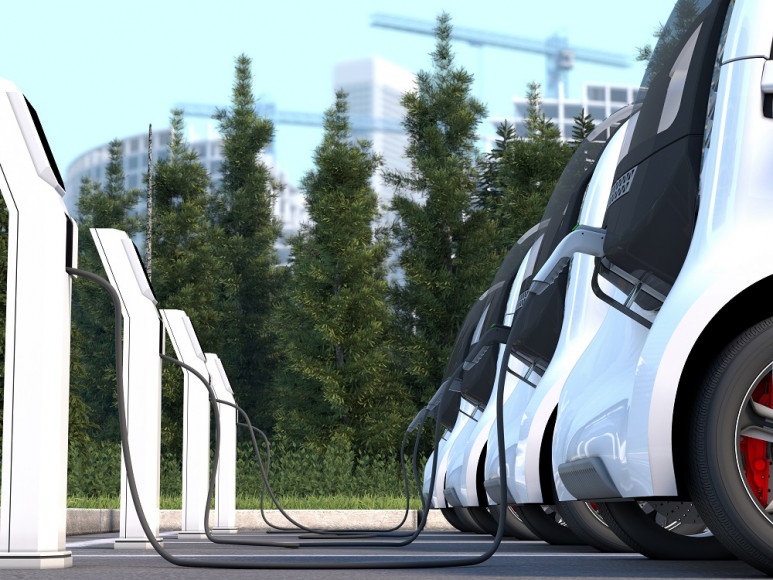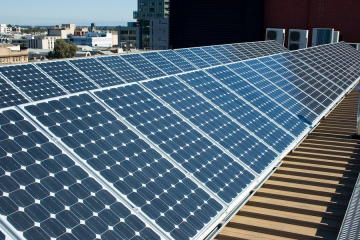The conversation around corporate sustainability has changed from a question of if to when. With many of the world's governments setting a target to limit temperature rise to 1.5 degrees Celsius by 2030, industries are examining what role they play in achieving this important outcome.
Corporations now seek to become leaders in reducing their carbon footprint. Aside from the clear climate benefit, this move makes great business sense. Public opinion is in favor of sustainable practices, and it shows in consumer spending habits. A recent survey found that 66% of global respondents (and 75% of millennials) say that brand sustainability practices influence their purchasing decisions.
Identifying and implementing carbon reduction opportunities might seem overwhelming, but your environmental, health, safety, and sustainability (EHS&S) team - or a trusted EHS&S consultancy - is well equipped to guide the process. Let's break down what reducing your corporate carbon footprint involves and how EHS&S professionals can lead the way.
To learn more about how you can get started on reducing your carbon footprint, reach out to our Energy Management services team.
Energy Management ServicesWhat is a Corporate Carbon Footprint
Every emission source that is directly or indirectly part of the process of doing business is included in calculating a corporation’s carbon footprint. Everything from energy consumption to supply chain greenhouse gas emissions are included, and while the scope of data needed to arrive at a calculated carbon footprint may seem daunting, there are services available to assist with determining your organization’s carbon footprint. A full analysis of your carbon footprint is an excellent tool for determining where to start making changes to reduce carbon emissions.
EHS&S Professionals: At the Forefront of Carbon Reduction
EHS&S professionals sit at the intersection of compliance, risk management, and sustainability - making them uniquely positioned to drive carbon reduction initiatives. Their expertise in regulatory frameworks, environmental impact assessments, and operational efficiency equips them to identify emissions hotspots and implement practical solutions.
The Business Case for Carbon Reduction
From lowering operational costs to mitigating risks and unlocking financial incentives, investing in sustainability strengthens both the bottom line and the company's long-term resilience.
ROI and Risk Mitigation
Sustainability has become a strategic advantage for businesses looking to reduce operational risks and future-proof their operations. For EHS&S professionals, the challenge often lies in translating carbon reduction into tangible business benefits that resonate with leadership. Fortunately, the return on investment (ROI) and risk mitigated tied to carbon reduction efforts make a compelling case.
Unlocking Finanical Incentives and Tax Benefits
Governments worldwide are rolling out financial incentives to encourage corporate carbon reduction. From tax credits for renewable energy adoption to grants for energy-efficient upgrades, there's no shortage of opportunities for businesses to offset the upfront costs of sustainability initiatives. In the US, programs like the Investment Tax Credit (ITC) for solar energy or rebates for LED retrofits can significantly reduce project payback periods.
Staying Ahead of Regulatory Changes
The regulatory environment is shifting rapidly. Early action on carbon reduction can position organizations as industry leaders while ensuring compliance with emerging mandates. EHS professionals who drive these initiatives are positioning their companies for long-term success - while avoiding potential penalties for inaction.
10 Tips for Reducing the Carbon Footprint of Your Business
There are ways businesses can reduce their carbon footprint while they wait for that analysis to be completed. Let’s look at 10 steps your corporation can take toward reducing its carbon footprint.
1. Change your Climate
Efficient regulation of indoor air temperature has benefits beyond reducing energy consumption. Many studies have shown that indoor temperatures can negatively affect worker productivity. HVAC systems and control technology have advanced to the point where it is easier than ever to regulate indoor temperatures by zone, time, or usage.
By improving your organization’s HVAC systems, you can ensure your indoor climate expenditures are going directly toward creating a comfortable and productive environment for your workforce.
2. Source Sustainable Energy
Powering your corporate campus with sustainable energy is an excellent way to reduce your carbon footprint. There are several ways to achieve this goal.
- Opt-in for purchasing power from renewable energy sources. Corporations can enter into a Corporate Power Purchase Agreement (CPPA) to purchase power produced through a sustainable source, typically a solar or wind farm. An additional benefit to this type of agreement is that the price is locked in for the term of the contract, protecting your organization against market fluctuations.
- Invest in your own solar or wind farms on or near your campuses. Not only is this an excellent way to reduce your carbon footprint, but it ensures your organization has power in emergencies that might otherwise affect the power grid.
- Purchase Renewable Energy Certificates (RECs). These are part of the carbon offset credit market system designed to balance out emissions through monetary support for clean energy production.
3. Make the Road Less Traveled
Reducing corporate travel is a helpful way to reduce your organization’s environmental impact since transportation is a major carbon culprit. Within this framework of corporate travel, there is a lot of room to create a balance between times when travel is required and when a remote or digital presence can accomplish the same end.
Hybrid work models have increased in popularity, and fewer cumulative hours of commute time are having a positive impact on emissions.
As hybrid work has increased, the technology to connect over digital platforms has improved. Online conferences are becoming easier to navigate and more seamless to host, offering opportunities to connect with large audiences without travel.
When travel is necessary, consider options that reduce overall emissions, such as carpooling, public transportation, and taking commercial airlines for air travel.
4. Upgrade your Lighting
This simple piece of advice can have a big impact. Consider all of the places your organization uses lighting: office buildings, warehouses, manufacturing plants, and parking lots. A lot of energy goes into keeping those places lit, especially in regions that see increased dark hours over winter.
Switching to LED bulbs can reduce your lighting energy consumption by 50%-70%. Other technology can help improve the energy efficiency of your lighting, such as motion sensors and timers that ensure lights in certain areas are only activated when needed.
5. Create a Local Food Stream
If your organization has a cafeteria, you can partner with local sustainable organizations to create a food stream that reduces waste and serves the community. Source locally grown foods where possible, compost food waste, and donate untouched foods to area kitchens that help community members in need. These are fantastic ways for your business to reduce its overall carbon footprint while making a difference locally.
6. Work with Sustainable Suppliers
Your organization’s procurement and purchasing departments can play a big role in reducing carbon footprint by working with sustainable organizations and suppliers who produce items that can easily be recycled or refurbished. Local suppliers are also a great option as they can simplify your supply chain while being a more sustainable option.
7. Reduce, Reuse, and Recycle on a Larger Scale
This slogan shouldn’t be limited to sorting bins. A department-by-department audit of waste production can uncover habits and practices that are low-hanging fruit for improving your organization’s carbon footprint.
You may find that certain single-use items can be replaced by multi-use alternatives, or with products that are recyclable rather than disposable. Accumulated paper files and old tech can be recycled. Processes can be streamlined to reduce overall waste.
8. Don’t Ignore your Data Center
The global shift to a digital workplace in 2020 increased internet traffic by 40% worldwide. As internet services improve in more areas of the world, the demand for data is growing exponentially.
The energy used to process all of that data is only a part of the equation. The glut of energy used to support data centers comes in the form of cooling infrastructure.
Stay on top of industry trends to make sure your data center isn’t increasing your carbon footprint, especially if your business uses AI.
9. Send Sustainable Products into the World
If your organization produces physical goods, you can greatly reduce your global carbon footprint by developing products that are designed with sustainability in mind. Use recyclable or compostable packaging. Move away from producing single-use items wherever possible. Make sure components of your product can also be recycled, refurbished, or composted.
10. Shift to an Electric Vehicle Fleet
Corporations are already leading the way in switching to electric vehicles. With major automobile manufacturers rolling out longer-range, more powerful electric vehicles every year, there are plenty of options available to upgrade your fleet to electric vehicles.
Creating a Carbon Reduction Roadmap
The key to effective carbon reduction is structure. EHS&S professionals know that without a clear, actionable plan, sustainability efforts can stall or lose focus. A phased roadmap helps companies move from ambition to execution - and it all starts with understanding where you stand.
Step 1: Conducting a Basline Greenhouse Gas (GHG) Inventory
Before setting targets, you need a clear picture of your current emissions. A GHG inventory measures emissions across operations, from direct (Scope 1) to indirect (Scope 2 and 3) sources. Targets and reductions will be measured against this baseline year. Tools like central energy monitoring systems or carbon accounting software can streamline this process, offering EHS&S teams a detailed breakdown of emissions hotspots.
Learn more: Measuring Carbon Footprints in Business Operations: A Complete Guide
Step 2: Building a Phased Action Plan
With baseline data in hand, the next step is developing a phased action plan. Start with low-hanging fruit - energy efficiency upgrades, waste reduction initiatives, and supply chain optimizations. From there, layer in mid-term projects like renewable energy procurement, supplier engagement, or electric vehicle adoption. Finally, set long-term goals for carbon neutrality or net-zero emissions, backed by initiatives like carbon offsetting or advanced carbon capture technologies.
Step 3: Leveraging External Expertise
EHS&S teams don't have to go it alone. External consultants specialize in guiding companies through the complexities of carbon reduction. From conducting initial assessments to mapping out actionable steps, third-party experts bring valuable insights and proven strategies that accelerate progress. Their experience across industries can help identify the most impactful initiatives for your specific business model.
Step 4: Tracking Progress and Adapting
Carbon reduction isn't a set-it-and-forget-it initiative. Regularly track progress against your roadmap, adjusting targets and strategies as new technologies emerge or regulations evolve. Transparent reporting on milestones - whether internally or through public sustainability reports - helps maintain accountability and keeps the company focused on long-term goals.
Want more news and insights like this?
Sign up for our monthly e-newsletter, The New Leaf. Our goal is to keep you updated, educated, and even a bit entertained as it relates to all things EHS and sustainability.
Get e-NewsletterHave any questions?
Contact us to discuss your environment, health, safety, and sustainability needs today.










